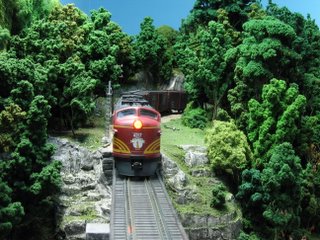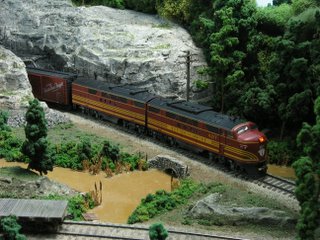 The B&M introduced EMD road diesels to New England in 1943 with an initial purchase of six A-B sets of FT freight haulers. The FT diesel made a significant contribution to the Boston and Maine in that it eradicated the need for electric helper service for steam locomotives through the lengthy Hoosic Tunnel. In effect, the EMD FT became known as the diesel locomotive that killed steam.
The B&M introduced EMD road diesels to New England in 1943 with an initial purchase of six A-B sets of FT freight haulers. The FT diesel made a significant contribution to the Boston and Maine in that it eradicated the need for electric helper service for steam locomotives through the lengthy Hoosic Tunnel. In effect, the EMD FT became known as the diesel locomotive that killed steam. Eighteen more A-B sets of FT's arrived on the property in 1944. Long freights were lensed by railfans in care of four unit A-B-B-A groupings of these beautiful diesel giants. By 1946, the railroad realized that a 5400 HP set of two FT pairs was unnecessary in many situations. As a result, the railroad purchased 18 new F-2's along with 3 booster units. The four-unit A-B-B-A combinations were split and F-2's were added to create the more reasonable A-B-A FT/F-2 lashups.
Eighteen more A-B sets of FT's arrived on the property in 1944. Long freights were lensed by railfans in care of four unit A-B-B-A groupings of these beautiful diesel giants. By 1946, the railroad realized that a 5400 HP set of two FT pairs was unnecessary in many situations. As a result, the railroad purchased 18 new F-2's along with 3 booster units. The four-unit A-B-B-A combinations were split and F-2's were added to create the more reasonable A-B-A FT/F-2 lashups.My version of the FT is a Stewart A-B model. I masked the sides of the A and B units and sprayed black paint over the grills to create a weathered appearance. I chose to number my model the number 4217 after I discovered a wonderful photograph taken by my good friend (and lifetime B&M towerman and train dispatcher Don Hills) of this locomotive in active service many years ago.
 I model the late 1950's, so I can still run these beauties although their remaining time on the railroad would be short-lived. In 1957, The Boston and Maine traded them in and their parts were used to produce the newer GP-9's that appeared on the railroad in a new blue, black and white paint scheme known as the "Bluebirds". While I model 1958, the year I was born, I've "imagineered" that these maroon and gold locomotives have survived one extra year of duty! :-)
I model the late 1950's, so I can still run these beauties although their remaining time on the railroad would be short-lived. In 1957, The Boston and Maine traded them in and their parts were used to produce the newer GP-9's that appeared on the railroad in a new blue, black and white paint scheme known as the "Bluebirds". While I model 1958, the year I was born, I've "imagineered" that these maroon and gold locomotives have survived one extra year of duty! :-)Cheers, Mike Hamer
Check out my other weblog which details my train operating round robin group at www.fridaynightgroup.blogspot.com
2 comments:
It is just great to see the interesting work you have done. I like the history. Maybe you can highlight some of your scenery making processes and techniques. How you started with one level for the track and created vertical depth?
Hi Chris and John, Thanks for your compliments. Chris has asked me to elaborate on my scenic work. When I designed the layout, I wanted all track to be on one level with no grades. I chose this route as it was my first layout ever and I wanted flawless train running running which has been the case for the past ten years the layout has been running and something I am very proud of. With all trackwork at one level, I chose to visually enhance the layout with scenery falling well below track level and scenery rising high above the trains. Creative benchwork design with the utilization of styrofoam to build up the scenery meant for quick and easy landscape formation. I painted the styrofoam black before adding the groundfoam and the 1500 trees made from flowers from my garden. By having scenery descend and ascend below and above the trackwork, I've managed to create some very interesting photogenic scenes along the layout's route. Thanks for the query, Chris...and thanks for the complimentary words John.
Post a Comment